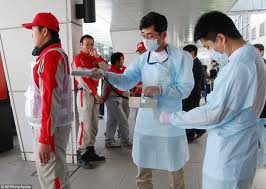
 Despite assurances from officials that the situation is well in hand and to remain calm, more reports of radioactivity away from the Fukushima plant are raising concerns about contamination spreading.
Despite assurances from officials that the situation is well in hand and to remain calm, more reports of radioactivity away from the Fukushima plant are raising concerns about contamination spreading.
From the Montreal Gazette:
Radioactive iodine in the sea samples was 126.7 times the allowed limit, while caesium was 24.8 times over.
The Health Ministry said residents of five municipalities in Fukushima should not use tap water for baby powder milk after the water was found to have more than the standard level of radioactive iodine allowed for babies. Authorities have also stopped shipments of milk and some vegetables from the area.
VOA wrote: Japan is now halting the sale of raw milk from Fukushima prefecture and spinach from Ibaraki prefecture. Officials late Sunday revealed that two more vegetables, canola and chrysanthemum greens, have also been found to be contaminated and in three more prefectures.
VOA also reported: Elevated levels of radioactive materials in sea water off Fukushima are raising concerns that Japan’s important fishing industry will be hit with an even deeper blow.
Recap
Sunday, March 20
Power cables were laid to reactor #2 but not made operational. Cooling systems for #6 were restarted and apparently #5 and #6 reactors were returned to a normal state. Chief cabinet secretary Edano confirmed that Fukushima will be permanently closed once the crisis is over.
Monday, March 21
Grey smoke appeared from reactor #3 for approximately 2 hours. Employees were evacuated but no other changes like rises in radiation were seen. White smoke was seen from #2 but was thought to be steam. This was accompanied by a rise in radiation but this proved to be temporary.
Tuesday, March 22
“Smoke” was still coming from #2 and #3 but may have been steam following operations to spray water onto the buildings. Work resumed after radiation checks were made and proved to be negative. The task to connect power cables to units one, two, and three continue however it is not known at this time if the previous explosions have damaged the cooling systems. They may prove to be non-functioning.
TEPCO has issued a statement that a 0.5 litre sample of sea water ‘in the vicinity of the outlet [of the plant]’ has revealed an iodine-131 increase of 126.7 times ‘above standard levels’, among increases of other isotopes. (Wikipedia) The TEPCO status report shows the words “fuel exposed” for reactors one, two, and three.
Opinion
Does anybody really know what’s going on? I read statements like “Radioactive iodine in the sea samples was 126.7 times the allowed limit, while caesium was 24.8 times over.” (The Montreal Gazette) Then I read that TEPCO says this does not pose an immediate danger. Another statement from the papers reads, “The Health Ministry said residents of five municipalities in Fukushima should not use tap water for baby powder milk after the water was found to have more than the standard level of radioactive iodine allowed for babies. Authorities have also stopped shipments of milk and some vegetables from the area.”
After all that, I read that authorities have said that readings are much lower than around Chernobyl after the 1986 accident in Ukraine.
I’m sorry, just what the heck does that mean? Am I somehow supposed to feel better that readings of radioactivity are less than the world’s worst nuclear accident? Is this comparison just a tad ludicrous? Is it like saying, “Don’t worry. You are much safer than if you fell into an active volcano?”
I could go on and on with amusing comparisons like this, but I think the point is that transparency about the gravity of the nuclear accident may not forthcoming, TEPCO and other officials may not understand just what the gravity of the situation is. At this stage of the game, I wonder if there are not more of crossed fingers in a sign of good luck than a fully developed plan to deal with a crisis which has passed all pre-defined safety procedures. After this “little incident”, just what is the future for nuclear energy?
Elsewhere
Kyodo news agency is reporting today that the official death toll is 9,080 with 13,561 missing. There are 270,000 evacuees, including those from the areas around the Fukushima nuclear power plant, who are living in 1,900 shelters in 16 prefectures.
Euronews – Mar 22/2011
Smoke rising from Fukushima plant raises alarm
Fears of radiation spreading have risen ten-fold after smoke was seen rising from two of the most threatening reactors at Japan’s stricken Fukushima nuclear plant. Technicians have however managed to attach power cables to all six reactors and started a cooling pump at one of them.
Russia Today – Mar 22/2011
Radiation level 1,600 times above norm in Fukushima nuke zone
Work to restore power and crucial cooling functions resumed Tuesday morning at the crisis-hit reactors at the quake-stricken Fukushima Daiichi nuclear power plant, following suspension Monday after smoke was detected at its No. 2 and No. 3 reactors, its operator said. Meanwhile, radiation 1,600 times higher than normal levels has been detected in an area about 20 kilometers from the crippled Fukushima Daiichi nuclear power plant, IAEA said.
http://www.youtube.com/watch?v=zxAv-REH5ZA
Click HERE to read more from William Belle
Article viewed at: Oye! Times at www.oyetimes.com

Be the first to comment